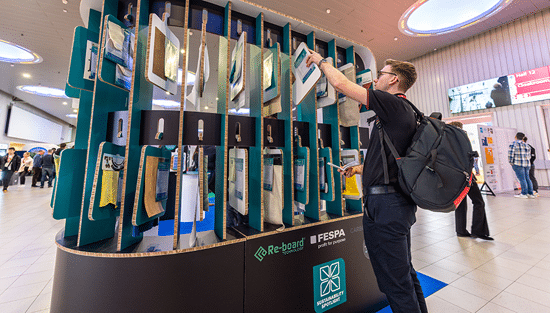Press-ready files – who is responsible?
FESPA Colour Ambassador Paul Sherfield asks if the client or the printer should ensure that files are press ready.
Whether press-ready files should be the responsibility of the client or the printer has long been an area of contention in all market sectors of the printing industry – commercial, publishing, packaging, wide format and so on.
Over many years I have spoken and written on this subject. So when FESPA asked me to write this article, it gave me the opportunity to collect my thoughts on this topic.
Basic client errors
Printers often complain they receive poor files with basic errors. These include the following:
- Fonts not embedded
- No trim marks or bleed
- Low resolution images
- Incorrect colour space and /or colour profile
- Rich black
- Incorrect use of special colours in a 4-colour process only production
- PDF made from non-professional graphic arts applications
The list could go on!
Then the printer often has to preflight and correct the file, usually at no cost as they are told by the client, ‘My other suppliers do not charge me for this.’
So what are the issues and opportunities in this area?
- Should the client be required, via its graphic designers, to provide ‘print ready files’ to the printer’s specifications and the printer change if the files are incorrect?
- Do printers give sufficient detailed information on how to prepare files for their production methods and substrates?
- Are graphic designers trained at college in this key design production area?
Looking into the past, pre-PDF, it was always stated in printer estimates that they required ‘camera-ready artwork’, physical artwork ready for analogue production. If it was poorly supplied it incurred extra costs or was returned to the client for amendment.
In the very old days of typesetting there was an extra cost incurred if ‘bad copy’ was supplied. This often meant illegible writing, poor spelling and grammar. Different days now, I think.
Must-do list for clients
What type of files should a client supply to their printer? PDFs, open application files from Adobe InDesign and Illustrator, Quark Xpress or image files formats such as TIFF, JPEG, PNG, PSD or even HEIF. None of these file formats are incorrect if both their type and specifications have been agreed with the printer as fit for purpose.
For any file supplied for printing, the image size, resolution, colour space and ICC profile must be correct for the printing process and substrate. Also, it must be remembered that the image file formats are raster files and will not work well with fonts and other vector elements.
The file type chosen will often be determined by the product. Commercial and publication market areas have long specified PDF files based on the range of PDF/X standards from the Ghent Workgroup (GWG). These standards have now been extended to include packaging, point of sale and digital printing.
The PDF/X range of PDF standards (the X denotes ‘exchange’) are PDF settings for the graphic arts and printing sectors. They mandate areas such as embedded fonts, trim and bleed boxes and so on, and do not allow unprintable PDF features such as sound files and videos.
The GWG specifications in these areas should form the basis of any printers’ guidelines to clients on how to supply press-ready files. Downloadable PDF/X presets are available for all the above market areas for applications such as Adobe InDesign, Acrobat, Quark Xpress and many of the PDF preflight softwares.
However, even these PDF/X based presets, either from the GWG or from within DPT software, may need changes. Areas such as image resolution and CMYK profiles and output intents may need changing. Indeed, the standard presets for PDF/X in Adobe InDesign may be incorrect for some printing processes and markets.
So, as an example, let’s look at these settings and the possible changes needed in Adobe InDesign using the latest PDF/X-4 specifications.
Exporting PDFs the right way
This is the opening screen from the ‘Export Adobe PDF’ presets under ‘File’. This is normally not altered other than if separate PDFs are needed for each page.

The next screen is for compression, image resolution, quality and file size. While the default 300ppi is fine for most work, smaller image resolutions may be considered for point of sale and other markets where the printed product is viewed from a distance.

The next screen is for setting any trim and bleed marks needed.

The next screen is one of the most important. It defines the CMYK profile, who converts to the chosen profile and when. The default setting chooses the CMYK profile, in this case PSO Coated v3 (Process Standard Offset) from the colour setting file in InDesign. However, again by default, it will not convert any images to this profile, but instruct a PDF/X-4 compliant workflow at the printers to convert to this profile. This is called an ‘output intent’.
So, again, the printer should give guidelines on conversion and CMYK profiles to use. Also see below.

If the client or the printer wishes to have PDF/X-4 files converted to CMYK, then within the PDF/X-4 specification this is allowed.
Select the ‘Colour Conversion’ box in the ‘Colour’ panel and select as shown. This will default to the ‘Working CMYK’ from the colour settings in InDesign, in this case PSO Coated v3.
The printer should give guidelines on which CMYK profile is to be used.

This shows that to make a press-ready file, PDF or any other format, there needs to be a concise exchange of requirements from the printer to the client based on the printing process, substrate and product usage.
Summary and action points
PDF/X-4 files are increasing the choice for submitting and exchanging files. These will provide a PDF suitable in structure for press-ready files: fonts embedded, trim and bleed boxes, and a printing condition or ICC profile specified within the file. However differing printing processes, substrates and products require differing image resolutions and CMYK profiles while still adhering to the PDF/X-4 standard.
There seem to be a number of approaches a printer can take to ensuring that files are press ready.- Give basic information only to their clients on file creation and expect to have to preflight and correct files, building this cost into their overhead. As long as the printer has the knowledge, systems and automated correction and colour conversion software combined into their workflows and digital front-ends, this is a reasonable approach that can be marketed to clients as a service.
- Request a very ‘open’ PDF file using a PDF preset that can then be processed using the printer's PDF and colour workflows. This could be based on the emerging ‘exchange’ CMYK and RGB ICC profiles from FOGRA and Idealliance’s G7 work. The aim here is to produce and use a CMYK or RGB profile that encompasses all the colours needed for a range of product and printing methods. FOGRA has eciCMYK for this use in the commercial and publishing sectors. It is also working on a RGB profile for the digital printed textile sector. This depends on the printer knowing how to repurpose to the correct ICC profile for the printing method and substrate.
- A more proactive approach is to create and publish comprehensive guidelines on colour management and PDF/X-4 or other file type creation. In some cases, this may include for large clients, installing these presets at a client and training their design staff in their use. A very good way of creating more client retention.
Finally, the case needs to be made to the design colleges that they should include this important area within their syllabus. Surely a graphic designer should know how to produce a press-ready file. Can you imagine an architect who cannot produce accurate drawings for the buildings they design? So why should graphic designers leave college without this knowledge?
Become a FESPA member to continue reading
To read more and access exclusive content on the Club FESPA portal, please contact your Local Association. If you are not a current member, please enquire here. If there is no FESPA Association in your country, you can join FESPA Direct. Once you become a FESPA member, you can gain access to the Club FESPA Portal.
Topics
Recent news

New sustainable materials at Sustainability Spotlight
Sustainability Spotlight returned by popular demand to FESPA Global Print Expo last month in an exhibit curated by The Good Factory.

Sportswear Pro: building ‘Brand Me’
After the success of the inaugural Sportswear Pro last month, we spoke with panellist and personalisation expert James Lawrence-Jones about the most exciting revelations at the event.

